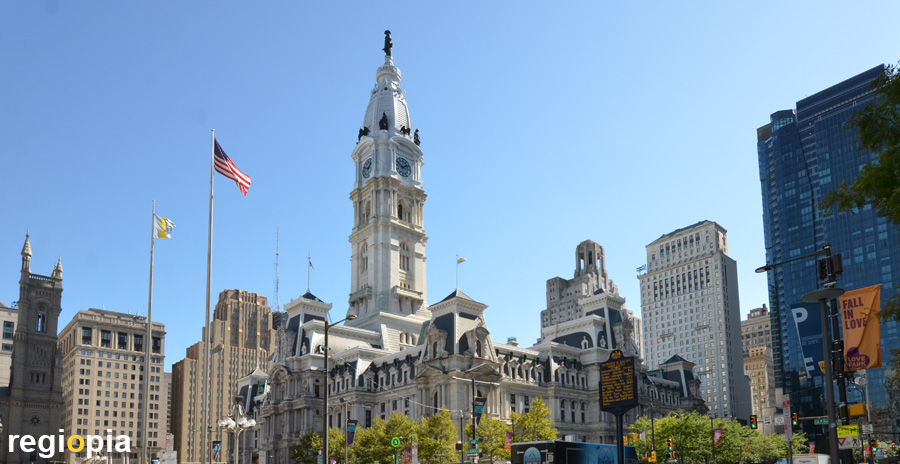
Philadelphia City Hall
City Hall is the landmark of Philadelphia. The city hall is situated at the center of William Penn's historic founding of the city. It's at the intersection of Market Street and Broad Street. If you stand on one of the two main streets, you can always see the city hall.
Philadelphia City Hall was built in the Victorian style between 1871 and 1901. However, the architect John McArthur Junior did not live to see the completion, as he died in 1890. He designed a monumental ensemble on a square floor plan with a side length of around 130 m. The French-style mansard roofs of the building are surmounted by a 167 m high tower with a statue of William Penn on top. The city hall tower is not in the middle of the building, but on the north side of the inner courtyard. The tower can therefore be seen from Broad Street but not from Market Street. Instead you can see the tower from Benjamin Franklin Parkway, which runs diagonally towards the tower.
When the City Hall opened, it was the tallest office building in the world. But it could only defend this title until 1908, when the Philadelphia City Hall was surpassed by the 187 m high Singer Building (demolished in 1968) in New York City.
The City Hall remained the tallest building in Philadelphia until 1987, when it was surpassed by One Liberty Place (269 m). Due to its prominent position in the street grid, the City Hall remains the dominant building in Philadelphia.
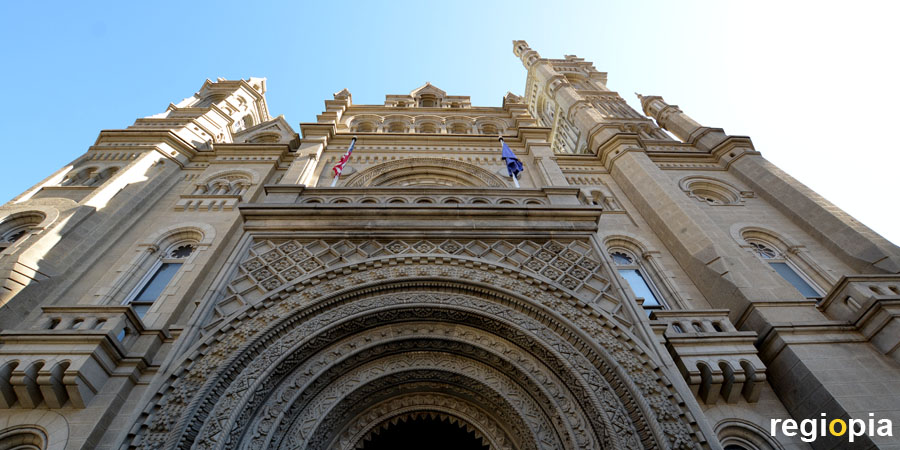
Philadelphia Masonic Temple
If you leave the inner courtyard of the City Hall towards the north you stand in front of the Masonic Temple. The Philadelphia Masonic Temple was built in 1873. The architect James H. Windrim ran the budget to the full. The outer facade is reminiscent of Norman architecture, as was common in medieval England. Due to the detailed design, the Masonic Temple is one of the most beautiful buildings in Philadelphia. The interiors were designed by George Herzog and clearly surpass the facade. George Herzog came from Munich and was the son of a stage painter. There is a hall in the Egyptian style of the pharaohs with slightly exaggerated coloring, a hall in the Moorish style, a hall in the Gothic style and a hall in the Romanesque style. The main hall in the Greek style with Corinthian capitals is a bit more discreet. Everything was very lavishly decorated, but for that very reason it is very worth seeing. For opening times and photos of the interiors, see link.
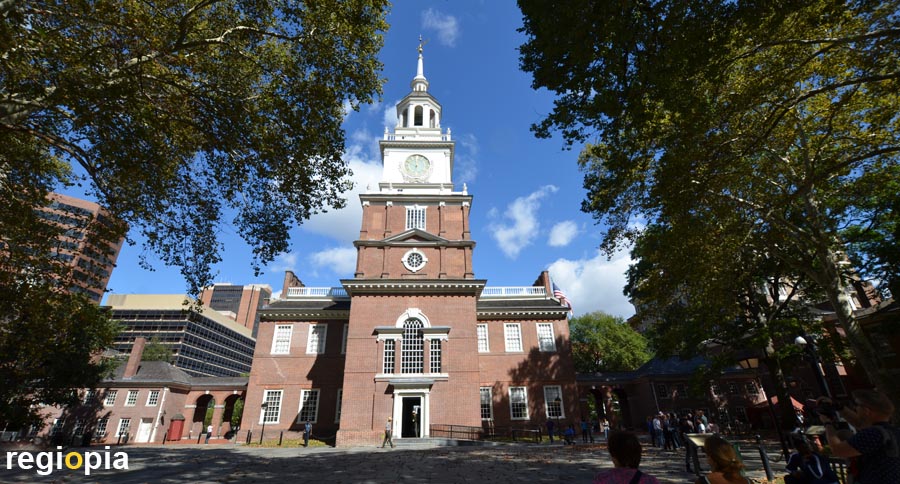
Independence Hall
Independence Hall is Philadelphia's most famous landmark. The United States' Declaration of Independence was signed in the former Pennsylvania parliament building in 1776. In 1787, the United States Constitution was passed here. This makes the Independence Hall the most important building of American independence. Because of its historical importance, it has been declared a World Heritage Site by the UNESCO.
The building was constructed according to plans by architect Edward Wooley until 1748 and opened under the name "Pennsylvania Sate House". The tower, reminiscent of a church tower, was built by William Strickland in the 19th century, as the previous one was dilapidated and had to be demolished. The Liberty Bell, which is now on display in the Visitor Center at the Independence National Historical Park, used to hang in this tower.
The bell was rung during the public reading of the Declaration of Independence in 1776 and is therefore a national symbol for freedom. On the bell is the inscription: "Proclaim Liberty throughout all the land unto all the inhabitants thereof". The crack in the Liberty Bell emerged in 1817.
www.nps.gov/independencehall.htm
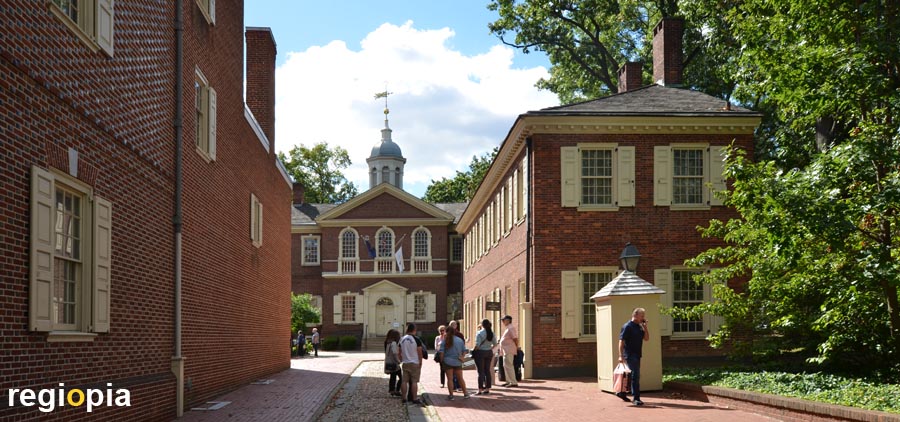
Carpenters Hall
The Carpenters' Hall was built as a guild hall for carpenters in 1774. In the same year the First Continental Congress met here with representatives from 12 of the 13 American colonies. Only Georgia remained loyal to the British Crown. The trigger for the First Continental Congress was the blockade of the port of Boston by the British Navy after the Boston Tea Party in December 1773. With this action the colonists protested against import tariffs on tea. All the colonies in America were outraged by the motherland's military action. A majority of the colonists were suddenly in favor of independence from Great Britain. They wanted to manage themselves and not pay taxes for wars in Europe.
At the First Continental Congress, a boycott on British goods was decided, which will not be lifted until Britain lifts its tariffs and withdraws the warships. Every aerican colony should set up a militia to defend itself. In addition, a Second Continental Congress was decided, which should take place in one year, in order to decide on further measures if England does not meet these demands.
Among the most famous attendees at Carpenters' Hall were later Presidents George Washington for Virginia and John Adams for Massachusetts. The Carpenters' Hall is now part of the Independence NHP.
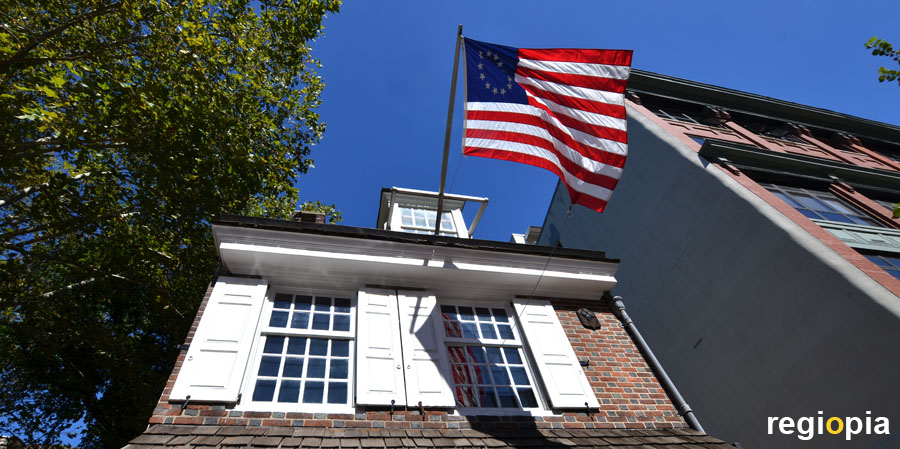
Betsy Ross House
The Betsy Ross House is one of the sights of Philadelphia because it is believed that the first US flag was sewn here. Elisabeth (Betsy) Griscom married John Ross, who attended the First Continental Congress. The couple had an upholstery shop in Philadelphia where they both worked. When John Ross died on a Pennsylvania military operation, Betsy Ross took over the business.
She received the order to sew the first flag of the USA in 1776 from George Washington, George Ross (the uncle of John Ross) and Robert Morris. The three gentlemen were signatories of the Declaration of Independence. According to legend, Washington roughly sketched the flag with six-pointed stars. Betsy Ross suggested using five-pointed stars. It is not known who actually designed the flag.
The first American flag had 13 stars arranged in a ring in a blue rectangle. The rectangle was in the upper left corner. The rest of the flag consisted of 7 red and 6 white stripes. The number 13 represents the number of colonies that participated in the revolution. The Canadian colonies were invited, but did not take part in the uprising against the British Empire.
Betsy Ross's second husband, Joseph Ashburn, died in British captivity in Yorktown. Her third husband was named John Claypoole. Betsy Claypool died in Philadelphia in 1836 at the age of 84. Her grave is on the property next to her house.
http://historicphiladelphia.org/betsy-ross-house
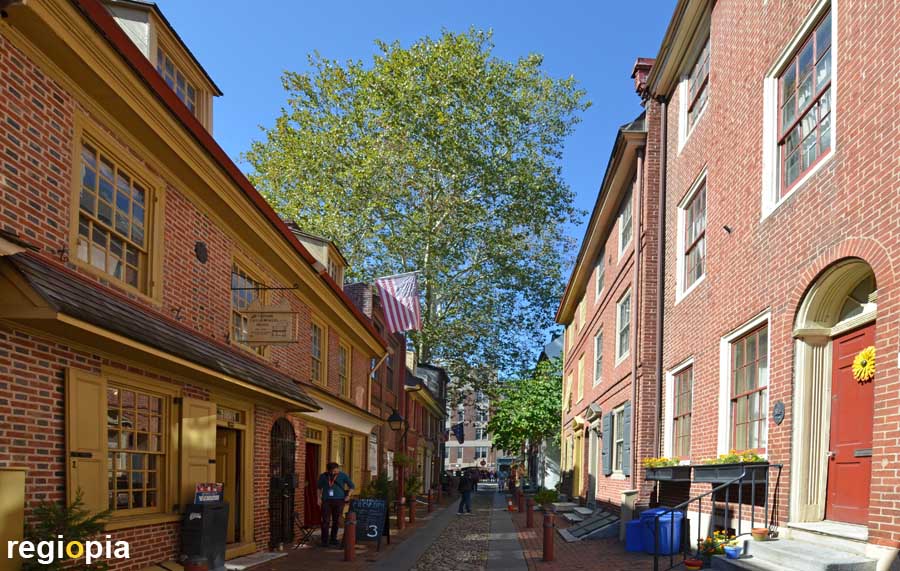
Elfreth's Alley
Elfreth's Alley is the oldest continuously inhabited street in the United States. William Penn founded Philadelphia in 1682 on the west bank of the Delaware River. The oldest houses on Elfreth's Alley were built in 1703. It is like a miracle that these houses are still standing today. This is the work of the Elfreth's Alley Association, which has been fighting for the preservation of the historic buildings since 1934.
The street is named after the blacksmith Jeremiah Elfreth who lived here in the 18th century. There were many different shops in the street back then. Due to the proximity to the port, the shops and residents changed constantly. The road was firmly in Irish hands by 1900.
Today the historic buildings have been cleaned up and are in very good condition. Elfreth's Alley is one of Philadelphia's top attractions and one of the city's most popular Instagram spots. In Elfreth's Alley Museum you can enter one of the houses (No. 124-126). The decor was modeled on colonial-style furniture.
ads
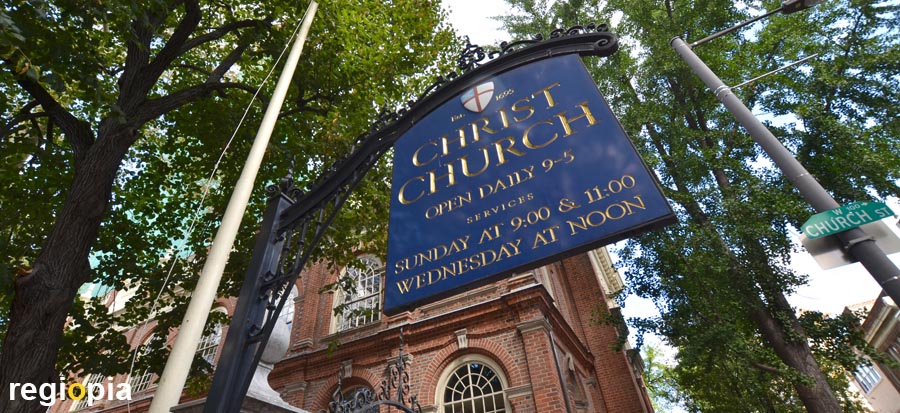
Philadelphia Christ Church
Christ Church was the first Protestant church in Philadelphia. The parish was founded in 1695 and a first wooden church was built on the property. The construction of today's brick church began in 1727. The 60 m high church tower was completed in 1754. After independence, the steeple of Christ Church was the tallest building in the United States.
The architect of the church is not known, only the construction manager John Kearsley is known. The architecture is inspired by Sir Christopher Wren, who rebuilt around 50 churches in London after the Great Fire of 1666. He was also the architect of St. Paul's Cathedral.
The architectural style of Christ Church, however, is a bit simpler and is therefore already assigned to the Georgian style, which followed the English baroque style. The nave is made of reddish bricks, while the slender tower is made of a white painted wooden structure. The interior is also white and plain, as it is common for Protestant churches. Only the fluted, Doric columns give the nave a bit of elegance.
The Christ Church was the church of the American Founding Fathers. George Washington, Benjamin Franklin and many other politicians attended the service here. The Christ Church Burrial Ground is by the way on Independence Mall and Arch Street. Benjamin Franklin's grave is located here.
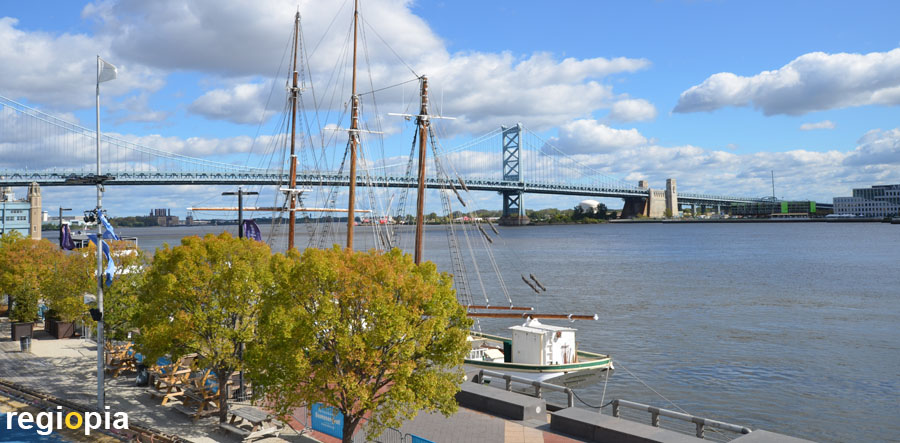
Penn's Landing
Penn's Landing is Philadelphia's waterfront on the Delaware River. William Penn's actual landing site was in Chester, a suburb south of Philadelphia. Penn decided to build his new town further upstream. Penn's Landing is where the city of Philadelphia was founded. The new city grew from this point to the west.
Today, the waterfront is separated from the rest of the city by Interstate 95, which runs along the river and connects Florida with Maine. Penn's Landing is a small strip of land between the freeway and the Delaware River, connected by bridges to Walnut St. and Chestnut St. The promenade looks a bit old fashioned, but the view on the wide Delaware River is still worth it. At the river bank is the Independence Seaport Museum with a harbor basin in which several historical ships are moored, such as the Becuna submarine or the restaurant ship Moshulu. In the north you can see the Benjamin Franklin Bridge (photo). Across the river is the city of Camden, New Jersey, to which there is a ferry service from Penn's Landing. The battleship New Jersey is anchored in Camden.
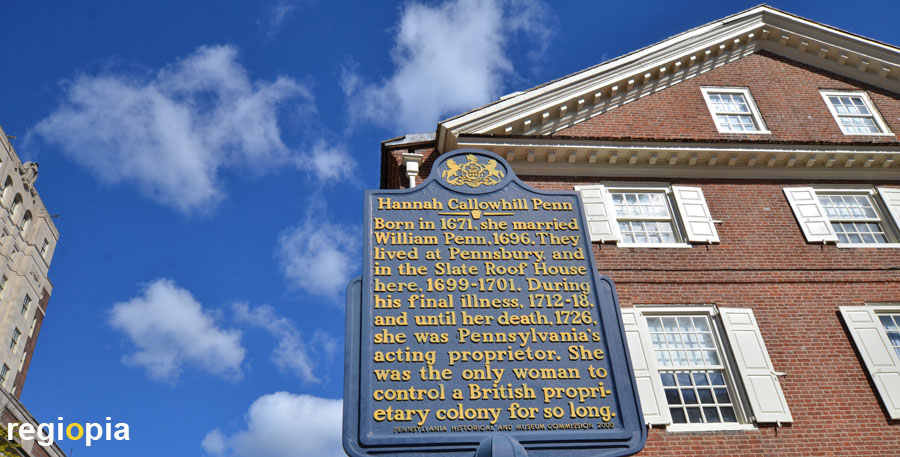
William Penn's Residence
William Penn's home was on S 2nd Street, between Chestnut and Walnut Streets. The "Slate Roof House" stood on a small hill. However, William Penn actually lived on his country estate at Pennsbury Manor about 25 miles north of Philadelphia. The Slate Roof House was rented and used as a town home for business. This house was demolished in 1867 and replaced by a larger structure. In 1982 the Welcome Park was created on the property. A square with the Philadelphia city grid, as designed by Penn. However, the residents did not stick to the plan, large blocks were divided by new streets and smaller streets were simply built over.
In the center of the square is a scaled-down copy of the statue of Penn, that stands on top of the city hall. The name "Welcome Park" refers to the name of the ship that William Penn sailed to America on in 1682. The life of William Penn is shown as a timeline on a wall on the south side of the square.
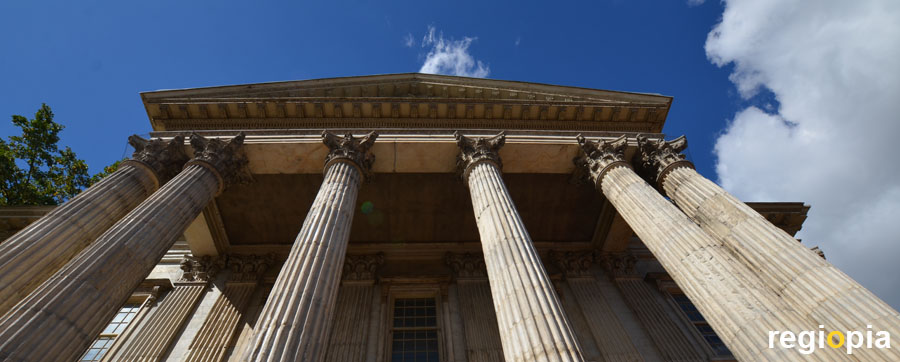
First Bank of the United States
With independence from Great Britain, which was won in 1783 through victory in the War of Independence, the young country needed its own currency. The First Bank of the United States was founded in Philadelphia in 1791, as the city was still the capital of the United States, Washington DC became capital in 1800. The country needed an institution to pay off war debts and manage tax revenues. The First Bank was the national bank of the USA, it replaced the Bank of North America, which was also founded in Philadelphia to finance the Revolutionary War. Since this institute was operated privately, the First Bank took over their war debts.
The building was opened in 1795. The structure was built in federal style by the architects Samuel Blodgett and James Hoban. The Federal Style is based on classical Greek architecture, the cradle of democracy. One wanted to break away from the British monarchy through architecture.
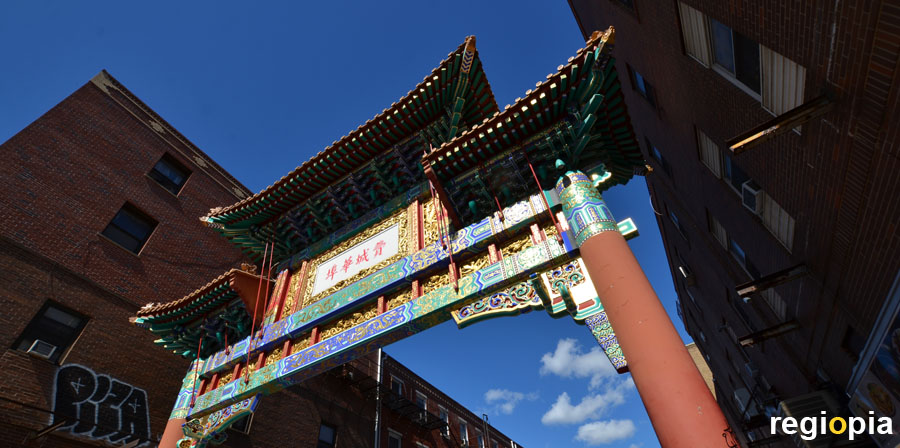
China Town Philadelphia
The China Town of Philadelphia emerged from 1870 onward when anti-Chinese attacks broke out on the west coast. Since the Chinese did not want to go back to their homeland, they moved to the east coast. With this "Driving Out" the Chinese settled in New York, Boston, Washington DC and Philadelphia. This was made possible by the first railway line, which connected both coasts in 1869 and was built also by Chinese workers.
Today around 3,000 Asians from different countries live in China Town. There are many restaurants with interesting specialties. The most famous sight is the Friendship Arch, a Chinese gate that was erected in 1984. It is a gift from the Chinese twin city Tianjin. The four characters on the gate mean Philadelphia China Town.
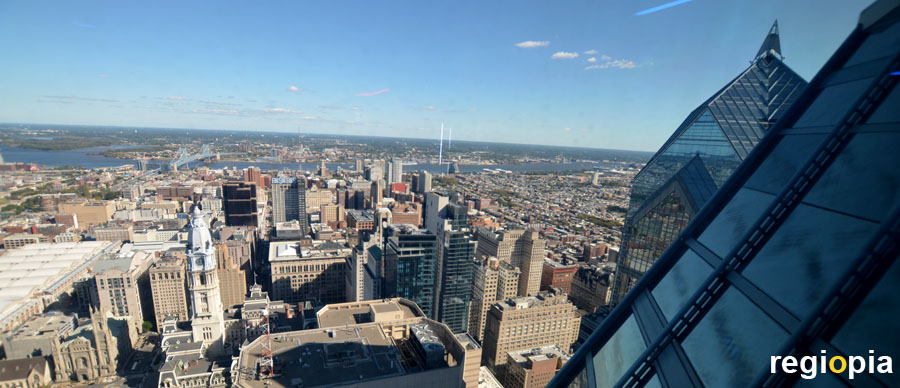
One Liberty Place
One Liberty Place is a 61-storey skyscraper designed by architect Helmut Jahn. The postmodern tower by the German-American architect was the first building to surpass the City Hall (167m). The glass tower is reminiscent of the Chrysler Building in New York and reaches a height of 288 m with spire. If you calculate the height up to the roof, the skyscraper still reaches an impressive 269 m. Even though One Liberty Place has already been surpassed by higher towers in Philadelphia. The observation deck offers a magnificent view of the whole city and is a top attraction of Philly. The photo shows the view to the east with City Hall to the left and the Delaware River in the background.
One Liberty Place was opened in 1987. The neighboring high-rise Two Liberty Place was built in 1990 and is 258 m high. The tallest skyscraper in Philadelphia is the Comcast Technology Center at 341.7 m.
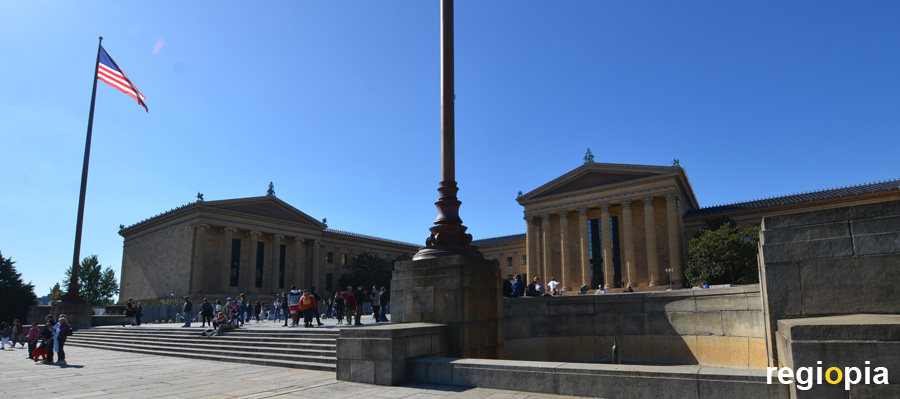
Rocky Steps
The staircase that leads to the Philadelphia Museum of Art became world famous by the movie "Rocky" in 1976. The Boxer Rocky Balboa trained for his greatest fight, running up those stairs and then posing like a winner with both arms up high in front of the Philadelphia skyline. The movie starring Sylvester Stallone became iconic and everyone who came to Philadelphia wanted to see the "Rocky Stairs". Once at the top, you can see his bronze footprints left in the ground, in the middle of the stairs. Every Rocky fan is photographed here with arms stretched up. At the foot of the stairs there is a sculpture of Rocky in this pose. It is one of Philadelphia's top Instagram spots.
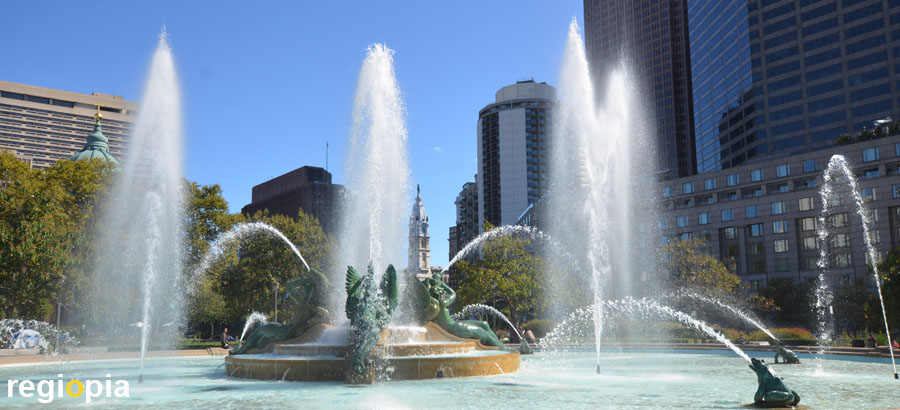
Swann Memorial Fountain
The Swann Memorial Fountain was built for Wilson Swann, the founder of the Philadelphia Fountain Society. The fountain by Alexander Sirling Calder symbolizes the three rivers of the city through a male native american Delaware River, a woman Schuylkill River and a girl Wissahickon. Frogs and turtles spit water into the center of the fountain, where a 15 m high water jet blows into the sky. The Art Deco fountain in the middle of Logan Square has been enchanting visitors and locals since 1924.
The sculptor of the fountain was the son of the sculptor who created the Penn sculpture on the Philadelphia city hall (Alexander Milne Calder). His son, in turn, was the world-famous Alexander Calder.
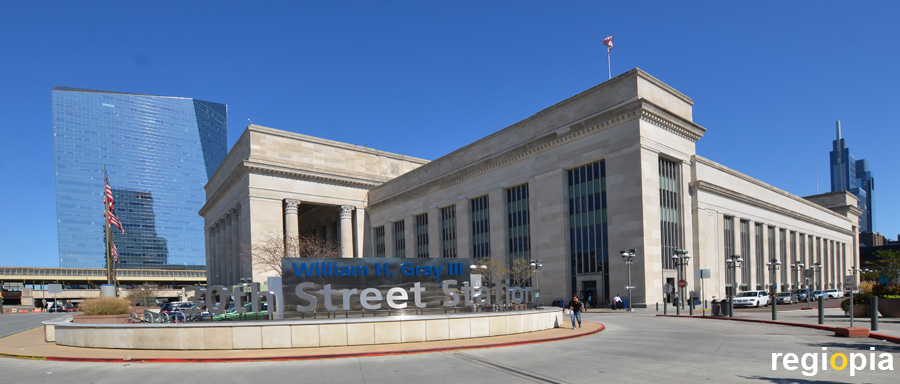
30th Street Station
30th Street Station is Philadelphia's main train station and one of the major rail hubs on the east coast. The station is in the west of downtown at the Schuylkill River, right on Market Street. The university district begins just behind the train station.
The beautiful entrance hall in neoclassical style with Art Deco details was designed by the architects Graham, Anderson, Probst & White. The monumental, light-flooded hall is clad with natural stone and is a prime example of American train station architecture. 30th Street Station opened in 1930.
The station is owned by the private rail company Amtrak. Philadelphia has rail connections to New York City, Washington DC, Chicago, Miami, Boston and many other cities. However, rail travel in the US is expensive and slow compared to Europe. West of 30th Street Station is the Philadelphia coach station. It's actually just a stop without a building. The bus connections are much cheaper than traveling by train, but they are also less convenient.
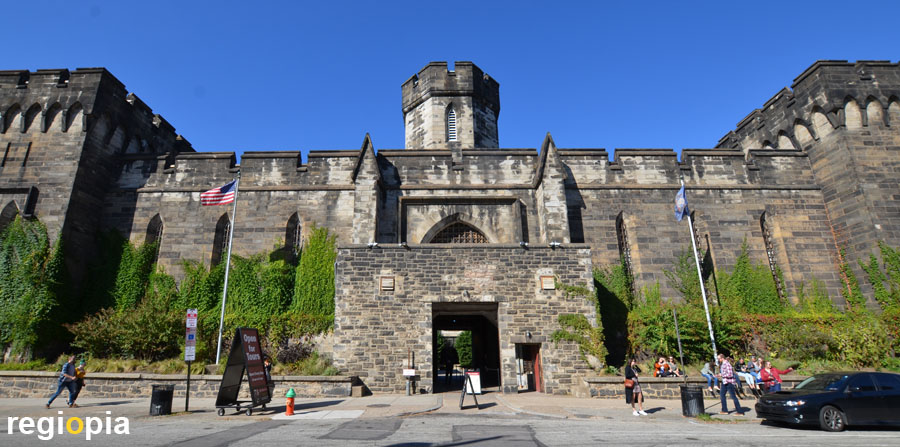
Eastern State Penitentiary
Eastern State Penitentiary opened in 1829. It was the largest public building in the United States at the time. The prison had a new principle of dealing with prisoners. Eastern State Penitentiary was not a labor camp, as was the norm at the time. The inmates had their own cell and were no longer physically abused by the staff. The exception proves the rule. The novelty of the Eastern State Penitentiary was the design. The cell blocks were arranged like the spokes of a wheel around a central courtyard. One guard could monitor all of the cell blocks at the same time. This system saves staff and has been copied worldwide.
From the outside, the prison looks like a medieval castle with massive walls, towers and battlements. The most famous inmate was Al Capone, the famous Chicago gangster. The Eastern State Penitentiary closed in 1971 and is now a spooky attraction of Philadelphia.
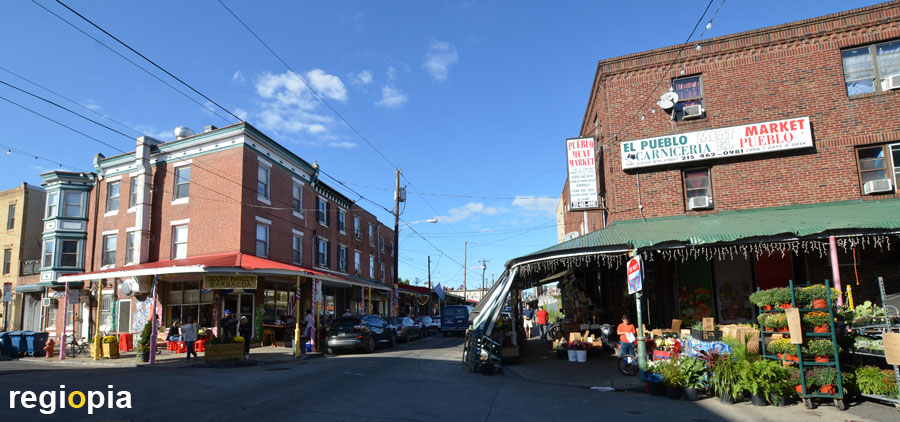
Italian Market
9th Street in South Philadelphia is one of those must-see streets if you go to Philadelphia. The interesting part of the street is between Christian Street and Wharton Street. We start at the corner of S 9th / Christan St. and walk south. This is where the Italian Market begins, Philadelphia's Little Italy with Italian shops and restaurants. If you follow the street further south you come to the Mexican quarter with many fruit and vegetable stalls. From Federal Street onward you are back in the USA, here are the famous Philly Cheesesteak restaurants Geno's Steaks and Pat's King of Steaks. If you want to walk even further, you should follow Passyunk Avenue. This street is getting hip and cool restaurants and bars line the street up to S Broad Street. You can quickly return to the city center from Snyder metro station.
Map of Philadelphia
ads
Philadelphia Travel Guide
ads
ads


